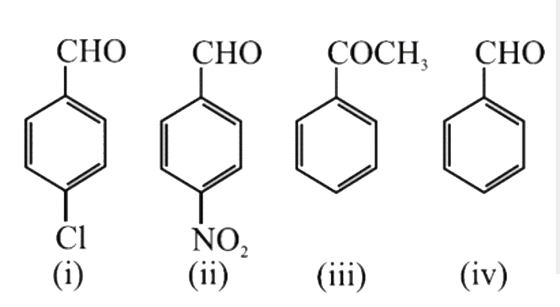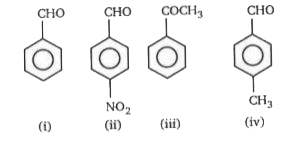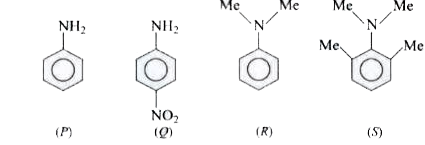Arrange the following compounds in an increasing order of their reactivity in nucleophilic addition reations: Ethanal, propanal, propanone, butanone.
To arrange the compounds ethanal, propanal, propanone, and butanone in increasing order of their reactivity in nucleophilic addition reactions, we need to analyze the structure of each compound and the factors that influence their reactivity.
1. Identify the Compounds:
- Ethanal (acetaldehyde): CH3CHO
- Propanal: CH3CH2CHO
- Propanone (acetone): CH3COCH3
- Butanone: CH3COCH2CH3
2. Understand Nucleophilic Addition Reactions:
- Nucleophilic addition reactions occur at the carbonyl carbon (C=O) of aldehydes and ketones.
- The reactivity of these compounds is influenced by two main factors: the partial positive charge on the carbonyl carbon and steric hindrance.
3. Analyze the Partial Positive Charge:
- Aldehydes (ethanal and propanal) have one alkyl group attached to the carbonyl carbon, which donates electron density and stabilizes the positive charge.
- Ketones (propanone and butanone) have two alkyl groups attached, which provide more electron donation, making the carbonyl carbon less positive and thus less reactive.
4. Compare Reactivity:
- Ethanal has the least steric hindrance and the highest positive charge on the carbonyl carbon, making it the most reactive.
- Propanal has slightly more steric hindrance than ethanal but is still an aldehyde, so it is more reactive than ketones.
- Propanone has more steric hindrance than propanal and is less reactive than both aldehydes.
- Butanone, like propanone, has two alkyl groups, but the additional carbon increases steric hindrance, making it the least reactive.
5. Order the Compounds:
- Based on the analysis, we can arrange the compounds in increasing order of their reactivity in nucleophilic addition reactions:
- Butanone < Propanone < Propanal < Ethanal
Final Order:
Butanone < Propanone < Propanal < Ethanal
- Ethanal (acetaldehyde): CH3CHO
- Propanal: CH3CH2CHO
- Propanone (acetone): CH3COCH3
- Butanone: CH3COCH2CH3
- Nucleophilic addition reactions occur at the carbonyl carbon (C=O) of aldehydes and ketones.
- The reactivity of these compounds is influenced by two main factors: the partial positive charge on the carbonyl carbon and steric hindrance.
- Aldehydes (ethanal and propanal) have one alkyl group attached to the carbonyl carbon, which donates electron density and stabilizes the positive charge.
- Ketones (propanone and butanone) have two alkyl groups attached, which provide more electron donation, making the carbonyl carbon less positive and thus less reactive.
- Ethanal has the least steric hindrance and the highest positive charge on the carbonyl carbon, making it the most reactive.
- Propanal has slightly more steric hindrance than ethanal but is still an aldehyde, so it is more reactive than ketones.
- Propanone has more steric hindrance than propanal and is less reactive than both aldehydes.
- Butanone, like propanone, has two alkyl groups, but the additional carbon increases steric hindrance, making it the least reactive.
- Based on the analysis, we can arrange the compounds in increasing order of their reactivity in nucleophilic addition reactions:
- Butanone < Propanone < Propanal < Ethanal
Butanone < Propanone < Propanal < Ethanal
Topper's Solved these Questions
- ALDEHYDES, KETONES AND CARBOXYLIC ACIDSBook:ICSEChapter:ALDEHYDES, KETONES AND CARBOXYLIC ACIDSExercise:EXERCISE (PART-II DESCRIPTIVE QUESTIONS) ( SHORT QUESTIONS)
Explore 581 Videos
- ALDEHYDES, KETONES AND CARBOXYLIC ACIDSBook:ICSEChapter:ALDEHYDES, KETONES AND CARBOXYLIC ACIDSExercise:ISC EXAMINATION QUESTIONS (PART-I OBJECTIVE QUESTIONS) (FILL IN THE BLANKS)
Explore 27 Videos
- ALDEHYDES, KETONES AND CARBOXYLIC ACIDSBook:ICSEChapter:ALDEHYDES, KETONES AND CARBOXYLIC ACIDSExercise:EXERCISE (PART-I OBJECTIVE QUESTIONS)
Explore 303 Videos
- ALCOHOLS, PHENOLS AND ETHERS Book:ICSEChapter:ALCOHOLS, PHENOLS AND ETHERS Exercise:ISC EXAMINATION QUESTIONS
Explore 25 Videos
- APPENDIX II ( TYPICAL CONVERSIONS)Book:ICSEChapter:APPENDIX II ( TYPICAL CONVERSIONS)Exercise:AROMATIC CONVERSIONS
Explore 98 Videos
Similar Questions
Arrange the following compounds in increasing order of their reactivity in nucleophilic addition reactions.
(i) Ethanal, Propanal, Propanone, Butanone.
(ii) Benzaldehyde, p-Tolualdehyde, p-Nitrobenzaldehyde, Acetophenone.
Hint: Consider steric effect and electronic effect.
View SolutionArrange the following carbonyl compounds in decreasing order of their reactivity in nucleophilic addition reaction :

View Solution
Knowledge Check
Arrange the following compounds in increasing order of their reactivity in nucleophilic addition reactions.
Ethanal, Propanal, Propanone, ButanoneAButanone lt Propanone lt Propanal lt EthanalBPropanone lt Butanone lt Ethanal gt PropanalCPropanal lt Ethanal lt Propanone lt ButanoneDEthanal lt Propanal lt Propanone lt ButanoneArrange the following carbonyl compounds in decreasing order of their reactivity in nucleophilic addition reaction.
 Aii>iii>i>ivBii>i>iv>iiiCiii>ii>i>ivDiii>i>iv>ii
Aii>iii>i>ivBii>i>iv>iiiCiii>ii>i>ivDiii>i>iv>iiArrange the following compounds in increasing order of acidity :
 AP>Q>R>SBS>Q>R>PCS>R>P>QDR>S>P>Q
AP>Q>R>SBS>Q>R>PCS>R>P>QDR>S>P>Q
Arrange the following compounds in the increasing order of their densities.

View SolutionArrange the following compounds in increasing order of their acidic strength.

View SolutionArrange the following compounds in increasing order of their boiling points.

View SolutionArrange the following compounds in increasing order of their boiling points
View SolutionArrange the following compounds in increasing order of basicity :

View Solution

